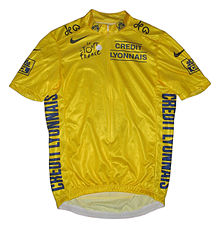Yellow jersey

The yellow jersey (French: maillot jaune ) is a rating jersey that is used in many stage races - especially the Tour de France - to recognize the leading participant in the overall standings or to identify them to the audience.
Yellow jersey of the Tour de France
history
There are some versions of how the first yellow jersey was made and when it was worn. In 1919 Henri Desgrange had the idea; the overall leader of the Tour de France should wear a yellow jersey so that he can be better recognized by the spectators. He chose the color yellow because his sports newspaper L'Auto was printed in yellow. Today's L'Équipe as the successor to L'Auto also appears in yellow with some issues. According to another version, the jersey color had to be yellow because no other jersey fabric was available in a hurry. On July 18, 1919, a picture of the overall leader in the yellow jersey appeared on the front page of the French magazine La Vie au Grand Air . This rider was Eugène Christophe on the 10th stage of the Tour de France. To this day, the yellow jersey on the Tour de France bears the small initials "HD" for the name of the Tour founder, Henri Desgrange.
Wearers of the jersey from German-speaking countries
So far (as of July 29, 2019) fifteen riders from Germany, ten from Luxembourg, five from Switzerland and one from Austria wore the yellow jersey at the Tour de France.
Germany
- Kurt Stöpel , 1 day: Tour de France 1932
- Erich Bautz , 3 days: Tour de France 1937
- Willi Oberbeck , 1 day: Tour de France 1938
- Rudi Altig , 18 days: Tour de France 1962 , 1964 , 1966 , 1969
- Karl-Heinz Kunde , 4 days: Tour de France 1966
- Rolf Wolfshohl , 2 days: Tour de France 1968
- Dietrich Thurau , 15 days: Tour de France 1977
- Klaus-Peter Thaler , 2 days: Tour de France 1978
- Jan Ullrich , 18 days: Tour de France 1997 , 1998
- Erik Zabel , 2 days: Tour de France 1998 , 2002
- Jens Voigt , 2 days: Tour de France 2001 , 2005
- Linus Gerdemann , 1 day: Tour de France 2007
- Stefan Schumacher , 2 days: Tour de France 2008
- Marcel Kittel , 2 days: Tour de France 2013 , 2014
- Tony Martin , 3 days: Tour de France 2015
Luxembourg
- Franz Faber , 25 days: Tour de France 1909 , 1910 , 1911 (overall leader; the yellow jersey was not yet available at that time)
- Nico Frantz , 37 days: Tour de France 1927 , 1928 , 1929
- Arsène Mersch , 1 day: Tour de France 1936
- Jean Majerus , 9 days: Tour de France 1937 , 1938
- Jang Goldschmit , 3 days: Tour de France 1950
- Bim Diederich , 3 days: Tour de France 1951
- Charly Gaul , 2 days: Tour de France 1958 (or on the 1st stage 1959)
- Kim Kirchen , 4 days: Tour de France 2008
- Fränk Schleck , 2 days: Tour de France 2008
- Andy Schleck , 7 days: Tour de France 2010 , 2011
Switzerland
- Ferdy Kübler , 11 days: Tour de France 1950
- Hugo Koblet , 11 days: Tour de France 1951
- Erich Mächler , 6 days: Tour de France 1987
- Alex Zülle , 3 days: Tour de France 1996
- Rubens Bertogliati , 2 days: Tour de France 2002
- Fabian Cancellara , 29 days: Tour de France 2004 , 2007 , 2009 , 2010 , 2012 , 2015
Austria
- Max Bulla , 1 day: Tour de France 1931
Overall leader's jersey in other cycling races and sports
The concept of a color-contrasting jersey was adopted for almost all stage races in cycling. Even the peace drive, which had long competed ideologically for a long time, relied on the yellow jersey. The largest cycling tours today, besides the Tour de France, vary the jersey color of the overall leader and award the pink jersey at the Giro d'Italia and the previously gold and now red jersey of the Vuelta a España .
In the meantime, other sports have adopted the yellow jersey award. World Cup leaders in biathlon , Nordic skiing or alpine skiing also wear a different colored jersey.
Individual evidence
- ↑ Photos of the magazine from 1903-…
- ↑ Lost film treasures: Tour de France 1959 (France, 2010), broadcast on Arte on July 16, 2011.